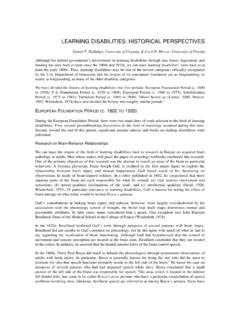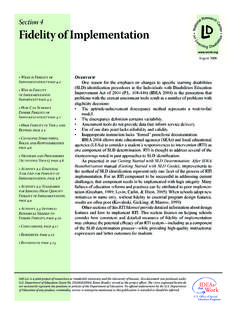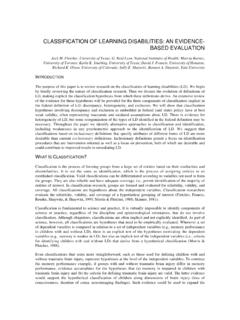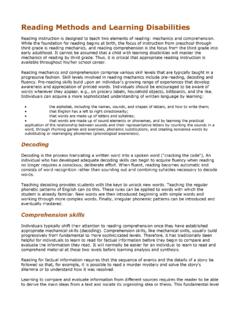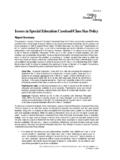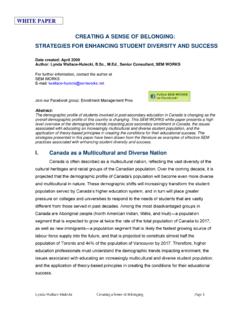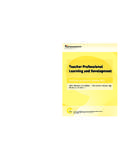Transcription of Section 5 School Examples, Student Case Studies, and ...
1 Section 5 school examples , Student case studies , and Research Examples School Examples, page School -Wide Screening, page Progress Monitoring, page Tiered Service Delivery, page Data-Based Decision Making, page Parent Involvement, page Resources, page Student case studies , page Bryanna, page Jayden, page Lauren, page Michael, page Resources, page Research Study Examples, page National Research Center on Learning Disabilities, page Centers for Implementing K-3 Behavior and Reading Intervention Models, page Resources, page is a joint project of researchers at Vanderbilt University and the University of Kansas.
2 This document was produced under Department of Education Grant No. H324U010004. Renee Bradley served as the project officer. The views expressed herein do not necessarily represent the positions or policies of the Department of Education. No official endorsement by the Department of Education of any product, commodity, service or enterprise mentioned in this publication is intended or should be 2006 OverviewIn November 2002, the United States Department of Education requested that the National Research Center on Learning Disabilities (NRCLD) identify, describe, and evaluate the implementation of responsiveness to intervention (RTI) in elementary schools throughout the United States.
3 The NRCLD staff worked with the six Regional Resource Centers (RRCs) to identify potential sites and solicit School participation. More than 60 schools across the country initially were considered, and information from 41 of those schools was submit-ted. The NRCLD research staff reviewed the extensive amount of information submitted and judged that 19 of those schools were engaging in one or more commendable RTI practices based on a review of the following six components of an RTI service-delivery model: School -wide screening.
4 Screening is a type of assessment characterized by quick, low cost, repeatable testing of critical academic skills or behaviors and can be administered by individuals with minimal amounts of training. A screening measures whether a Student should be judged at risk. If a Student meets the criteria for at-risk status, he or she is considered for more in-depth assessment. Screenings can use either a criterion referenced or normative comparison standard for measuring Student performance. Progress monitoring. Progress monitoring is a set of assessment procedures for determining the extent to which a Student or students are benefiting from classroom instruction.
5 When applied with rigor, progress monitoring ad-dresses the federal stipulations that students deemed as having a disability have not benefited from general education instruction. Tiered service delivery. The public health profession long ago adopted a tiered approach to services. This approach can be used to explain RTI tiered service delivery of increasingly intense interventions directed at more spe-cific deficits while targeting smaller segments of the population. In the pub-lic health example , the general population receives wellness information about how to stay healthy and receives broad vaccinations.
6 That is consid-ered the first or primary tier of intervention. However, some members of the general population might become ill or, as a result of large-scale screening, might need more specialized treatment. They could be judged as at risk for particular complications. This higher level is considered the secondary level of intervention, which is not provided to the general population but instead is provided for this smaller segment, maybe 10 to 15 percent of the general RTI National Research Center on Learning Disabilities August 2006population.
7 Within this smaller segment, some individuals, roughly 5 percent of the total popu-lation, are going to need very specialized inter-ventions. This highest level is called the tertiary level of intervention and by design is the most intense and most costly level of intervention. In the same way we understand that the general population benefits from receiving an optimal health intervention, we can imagine that all students would benefit from closely matching instructional and curricular approaches to their current level of functioning and need.
8 That is the role of tiered service delivery. Data-based decision making. Accurate imple-mentation requires a shared understanding of options ( , choices of interventions) and the basis on which those intervention decisions are made. By having a public, objective, and norma-tive framework of at risk, responsiveness, and unresponsiveness, School staff will have a basis for guiding their decisions. For example , when School staff and parents understand the expected oral reading fluency growth rates, de-cisions about a Student s responsiveness can be judged more accurately.
9 Parent involvement. Parent involvement is con-sistent, organized, and meaningful two-way communication between School staff and par-ents with regard to Student progress and related School activities. This communication allows parents to play an important role in their child s education. Fidelity of implementation. Fidelity of imple-mentation is the delivery of content and in-structional strategies in the way in which they were intended to be delivered. The delivery of instruction must be accurate and consistent.
10 Al-though interventions are aimed at students , fi-delity measures are focused on the individuals who provide the Section of the RTI Manual profiles informa-tion from some of the schools that engage in com-mendable RTI practices. Part One features schools that have implemented one or more of the RTI com-ponents. Part Two describes longitudinal data from individual students who have received services un-der an RTI delivery model. Part Three describes re-search studies that have employed RTI models. Section 5: School Examples, Student case studies , & Research ExamplesNational Research Center on Learning Disabilities August 2006 OneSchool ExamplesBackgroundIn this Section , we provide School -based exam-ples of five of the six components that are important to the implementation of an RTI service-delivery model.
